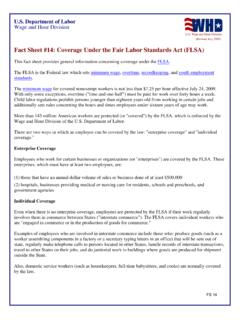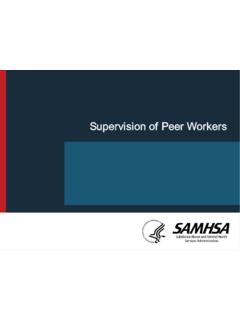Transcription of Covert Action and Clandestine Activities of the Intelligence …
1 Covert Action and Clandestine Activities of the Intelligence Community: Selected Definitions in Brief Michael E. DeVine Analyst in Intelligence and National Security Updated June 14, 2019 Congressional Research Service 7-5700 R45175 Congressional Research Service SUMMARY Covert Action and Clandestine Activities of the Intelligence Community: Selected Definitions in Brief This report provides background and definitions for Covert Action and Clandestine Activities carried out by the Intelligence Community (IC) and military. Congress has defined several of these terms in statute; others appear only in committee reports. Still others are military terms. These definitions describe Activities that support national security policy, and are, therefore, important to Congress s Intelligence and defense oversight responsibilities.
2 Confusion over the proper jurisdiction for congressional oversight can occur when Covert Action or Clandestine Intelligence Activities appear similar to certain military operations that may employ Clandestine methodology or have objectives similar to those for Covert Action . Intelligence and military matters fall under different authorities of the Code, and have, as a result, different statutory requirements for providing notification to Congress. Applicable statutes that govern Intelligence Activities under Title 50 of the Code emphasize prior notification to the congressional Intelligence committees for each separate activity. Under its Title 10 Code authorities, however, the Department of Defense generally provides notification of certain types of secret or Clandestine military operations to the Armed Services committees after their commencement, often by briefing Congress as part of a larger, supported military operation or campaign.
3 The IC, for example, in conducting a Covert Action , must generally provide prior notification to the congressional Intelligence committees by means of a presidential finding describing plans to have an Intelligence operation influence political, military, or economic conditions abroad while concealing sponsorship. The military, on the other hand, under Title 10, has the implicit authority to conduct operations that resemble Covert Action , but that DOD classifies as operational preparation of the environment (OPE). OPE is handled differently for oversight purposes, despite sharing with Covert Action a number of characteristics that heighten Congress s interest: a serious risk of exposure, compromise of information, loss of life, and a possible requirement to conceal sponsorship. An understanding of how these terms are used can help Congress navigate potential challenges in conducting oversight.
4 This report is the first of three reports on Covert Action and Clandestine Activities of the IC. The second, CRS Report R45191, Covert Action and Clandestine Activities of the Intelligence Community: Selected Notification Requirements in Brief, by Michael E. DeVine, describes the different statutory requirements for keeping Congress informed of these Activities . The third, CRS Report R45196, Covert Action and Clandestine Activities of the Intelligence Community: Framework for Congressional Oversight In Brief, by Michael E. DeVine, is intended to assist Congress in assessing the premises justifying Covert Action and Clandestine Activities , their impact on national security, operational viability, funding requirements, and possible long-term or unintended consequences. R45175 June 14, 2019 Michael E. DeVine Analyst in Intelligence and National Security For a copy of the full report, please call 7-5700 or visit Covert Action and Clandestine Activities of the Intelligence Community Congressional Research Service Contents Introduction.
5 1 Background .. 1 Defining Title 10 and Title 50 Authorities .. 3 Selected Terms, Definitions, and Descriptions .. 4 Covert Action .. 4 Clandestine Activities .. 5 Traditional Military Activities and Routine Support .. 6 Other-than-Routine Support .. 7 Operational Preparation of the Environment .. 7 Sensitive Military Operations .. 9 Sensitive Military Cyber Operations .. 9 Contacts Author Contact Information .. 10 Covert Action and Clandestine Activities of the Intelligence Community Congressional Research Service 1 Introduction Congressional oversight of the Intelligence community (IC)1 enables Members to gain insight into and offer advice on programs and Activities that can significantly influence foreign policy and its outcomes. This In Brief addresses Congress s ongoing interest in oversight of Covert Action and Clandestine Activities .
6 The distinction between government agency Activities described as Covert and Clandestine can be confusing. Which agencies are authorized to conduct Covert Action and Clandestine Activities ? What are their legal authorities for doing so? Which military terms describe Activities that might seem similar but are distinct from Covert Action ? Covert Action is codified as an activity or Activities of the United States Government to influence political, economic, or military conditions abroad, where it is intended that the role of the United States will not be apparent or acknowledged publicly. Covert operations are planned and executed as to conceal the identity of or permit plausible denial by the sponsor. 2 While not defined by statute, DOD doctrine describes Clandestine Activities as operations sponsored or conducted by governmental departments or agencies in such a way as to assure secrecy or concealment that may include relatively passive Intelligence collection information gathering Unlike Covert Action , Clandestine Activities do not require prior notice to Congress via a presidential finding, but may still require notification of Congress.
7 This definition differentiates Clandestine from Covert , using Clandestine to signify the tactical concealment of the activity. By comparison, Covert operations are planned and executed as to conceal the identity of or permit plausible denial by the sponsor. 4 Background Prior to 1974, no statute existed that enabled Congress to conduct oversight of the IC. Congress exercised what some have described as benign neglect of In earlier instances, when it could have exercised greater oversight such as over the CIA s orchestration of the 1953 coup in Iran Congress trusted that the executive branch and IC were acting in accordance with the law. Congress also did not question whether particular Covert actions or other sensitive Intelligence Activities were viable as a means of supporting national security. 1 The IC is a federation of 17 component organizations spread across two independent agencies and six separate departments of the federal government.
8 Many IC components reside within the DOD organizational structure, including the DIA, the NGA, the NRO, the NSA, and the Intelligence components of the military service branches. For more on the IC, see CRS In Focus IF10525, Defense Primer: National and Defense Intelligence , by Michael E. DeVine, as well as 108-458 (the Intelligence Reform and Terrorism Prevention Act of 2004, also known as IRTPA) and Executive Order 12333, as amended. See also Andru E. Wall, Demystifying the Title 10-Title 50 Debate: Distinguishing Military Operations, Intelligence Activities & Covert Action , Harvard National Security Journal, vol. 3, no. 1 (2011): 85-142. 2 Central Intelligence Agency, Glossary of Counterinsurgency Terms, May 19, 1962, at 3 Joint Chiefs of Staff, DOD Dictionary of Military and Associated Terms, April 2019, p.
9 37, at 4 Central Intelligence Agency, Glossary of Counterinsurgency Terms, May 19, 1962, at 5 James S. Van Wagenen, A Review of Congressional Oversight: Critics and Defenders (Washington DC: Center for the Study of Intelligence , Central Intelligence Agency, 2007), Covert Action and Clandestine Activities of the Intelligence Community Congressional Research Service 2 In the 1970s, controversy over public disclosure of the CIA s Covert Action programs in Southeast Asia and the agency s domestic surveillance of the antiwar movement spurred Congress to become more involved in Intelligence oversight. In 1974, the Hughes-Ryan amendment of the Foreign Assistance Act of 1961 ( 32 of 93-559) provided the first statutory basis for notification to Congress and congressional oversight of Covert Action operations. Investigations in 1975 by two congressional select committees in the Senate, chaired by Senator Frank Church, and in the House, chaired by Representative Otis Pike provided the first formal effort to understand the scope of past Intelligence Activities .
10 These committees became the model for a permanent oversight framework that could hold the IC accountable for spending appropriated funds ethically and legally and on programs and Activities that supported identifiable national security objectives. In 1976, Congress established the Senate Select Committee on Intelligence (SSCI), followed by the House Permanent Select Committee on Intelligence (HPSCI) in 1977. Congress later refined its oversight of the IC when the executive branch directed Covert Action operations without notifying Congress in advance. In August 1980, out of concern for maintaining operational security, President Carter chose not to inform Congress prior to the attempt to rescue American hostages held by the Iranian regime. In the mid-1980s, the Reagan Administration did not inform Congress about a Covert initiative to divert funds raised from the sale of arms to Iran to support the Contras in Nicaragua.
















